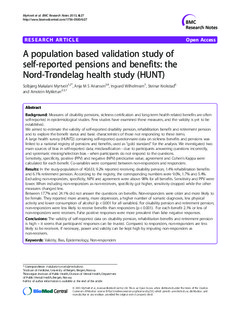| dc.contributor.author | Myrtveit, Solbjørg Makalani | |
| dc.contributor.author | Steinsland Ariansen, Anja Maria | |
| dc.contributor.author | Wilhelmsen, Ingvard | |
| dc.contributor.author | Krokstad, Steinar | |
| dc.contributor.author | Mykletun, Arnstein | |
| dc.date.accessioned | 2016-04-08T12:40:19Z | |
| dc.date.accessioned | 2016-04-21T07:56:49Z | |
| dc.date.available | 2016-04-08T12:40:19Z | |
| dc.date.available | 2016-04-21T07:56:49Z | |
| dc.date.issued | 2013 | |
| dc.identifier.citation | BMC Research Notes 2013, 6 | nb_NO |
| dc.identifier.issn | 1756-0500 | |
| dc.identifier.uri | http://hdl.handle.net/11250/2386621 | |
| dc.description.abstract | Measures of disability pensions, sickness certification and long-term health related benefits are often
self-reported in epidemiological studies. Few studies have examined these measures, and the validity is yet to be
established.
We aimed to estimate the validity of self-reported disability pension, rehabilitation benefit and retirement pension
and to explore the benefit status and basic characteristics of those not responding to these items.
A large health survey (HUNT2) containing self-reported questionnaire data on sickness benefits and pensions was
linked to a national registry of pensions and benefits, used as “gold standard” for the analysis. We investigated two
main sources of bias in self-reported data; misclassification - due to participants answering questions incorrectly,
and systematic missing/selection bias - when participants do not respond to the questions.
Sensitivity, specificity, positive (PPV) and negative (NPV) predicative value, agreement and Cohen’s Kappa were
calculated for each benefit. Co-variables were compared between non-responders and responders.
Results: In the study-population of 40,633, 9.2% reported receiving disability pension, 1.4% rehabilitation benefits
and 6.1% retirement pension. According to the registry, the corresponding numbers were 9.0%, 1.7% and 5.4%.
Excluding non-responders, specificity, NPV and agreement were above 98% for all benefits. Sensitivity and PPV were
lower. When including non-responders as non-receivers, specificity got higher, sensitivity dropped while the other
measures changed less.
Between 17.7% and 24.1% did not answer the questions on benefits. Non-responders were older and more likely to
be female. They reported more anxiety, more depression, a higher number of somatic diagnoses, less physical
activity and lower consumption of alcohol (p < 0.001 for all variables). For disability pension and retirement pension,
non-responders were less likely to receive benefits than responders (p < 0.001). For each benefit 2.1% or less of
non-responders were receivers. False positive responses were more prevalent than false negative responses.
Conclusions: The validity of self-reported data on disability pension, rehabilitation benefits and retirement pension
is high – it seems that participants’ responses can be trusted. Compared to responders, non-responders are less
likely to be receivers. If necessary, power and validity can be kept high by imputing non-responders as
non-receivers. | nb_NO |
| dc.language.iso | eng | nb_NO |
| dc.publisher | BioMed Central | nb_NO |
| dc.relation.uri | http://www.biomedcentral.com/content/pdf/1756-0500-6-27.pdf | |
| dc.rights | Navngivelse 3.0 Norge | * |
| dc.rights.uri | http://creativecommons.org/licenses/by/3.0/no/ | * |
| dc.title | A population based validation study of self-reported pensions and benefits: the Nord-Trøndelag health study (HUNT) | nb_NO |
| dc.type | Journal article | nb_NO |
| dc.type | Peer reviewed | nb_NO |
| dc.date.updated | 2016-04-08T12:40:19Z | |
| dc.subject.nsi | VDP::Medisinske fag: 700::Helsefag: 800::Epidemiologi medisinsk og odontologisk statistikk: 803 | nb_NO |
| dc.subject.nsi | VDP::Midical sciences: 700::Health sciences: 800::Epidemiology, medical and dental statistics: 803 | nb_NO |
| dc.source.volume | 6 | nb_NO |
| dc.source.journal | BMC Research Notes | nb_NO |
| dc.identifier.doi | 10.1186/1756-0500-6-27 | |
| dc.identifier.cristin | 1010899 | |
| dc.relation.project | Norges forskningsråd: 187912 | nb_NO |
| dc.description.localcode | © Myrtveit et al.; licensee BioMed Central Ltd. 2013. This article is published under license to BioMed Central Ltd. This is an Open Access article distributed under the terms of the Creative Commons Attribution License (http://creativecommons.org/licenses/by/2.0), which permits unrestricted use, distribution, and reproduction in any medium, provided the original work is properly cited. | nb_NO |

